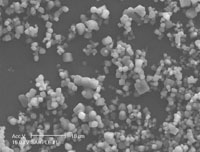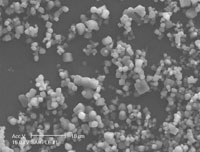Production of nanoparticles for inhalation drug delivery
II-11: Production of nanoparticles for inhalation drug delivery |
Ali Abbas,
Ian Purssell*,
Jose A. Romagnoli*,
Patricia Tang† and Kim Chan†
Division of Chemical and Biomolecular Engineering, Nanyang Technological University, Singapore
* The Department of Chemical Engineering, University of Sydney, Australia
† Faculty of Pharmacy, University of Sydney, Australia
|
Abstract |
|
Sodium chloride aerosols have been widely used as part of bronchial provocation tests to identify people with active asthma, exercised-induced asthma, and those who wish to enter particular occupations (e.g. police, army) or sports (e.g. diving). When sodium chloride is inhaled into the airways they increase the osmolarity of the fluid lining the mucosal surfaces. The bronchial muscle of an asthmatic will then contract with response to the rate of change of osmolarity.
The results of a rigorous experimental investigation on the effect of various parameters affecting the production of nanocrystals are presented. The experiments are conducted in a 1-L jacketed crystalliser. The sonication is induced by way of a sonication probe immersed into the crystallisation suspension. Temperature is controlled by a heating/cooling system. A concentrated solution of NaCl is crystallised with the use of ethanol as the antisolvent. Emphasis is laid on sonification intensity and temperature. The results indicated that optimal conditions exist that minimise the size of the crystals towards the nano range. Future work will assess solution concentration, feed rate and sonication time. The results will provide clear guidance for the subsequent step of process model development and thence process optimisation.
 |
|
 |
| Figure 1: SEM image of crystals from Experiment conducted under optimal conditions. |
|
Figure 2: SEM image showing (arrow) fusing of crystals. |
Correspondence may be addressed to Ali Abbas (aabbas@ntu.edu.sg). Work conducted at the University of Sydney. |
|
|



